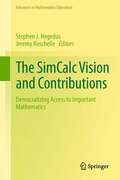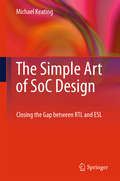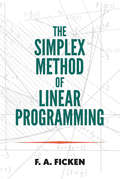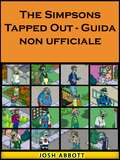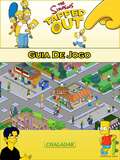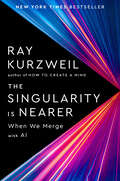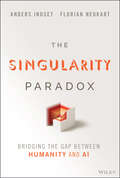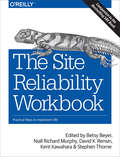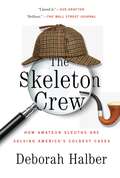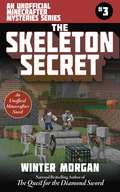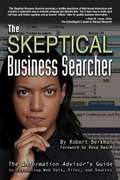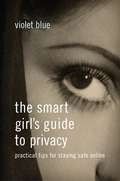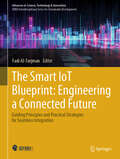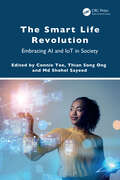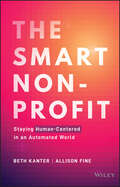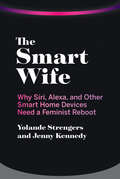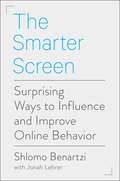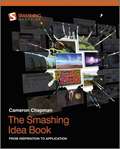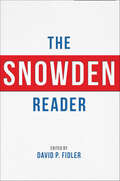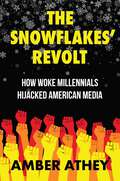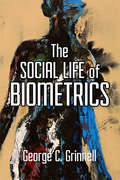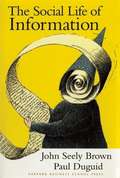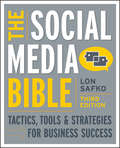- Table View
- List View
The SimCalc Vision and Contributions
by Jeremy Roschelle Stephen J. HegedusThis volume provides essential guidance for transforming mathematics learning in schools through the use of innovative technology, pedagogy, and curriculum. It presents clear, rigorous evidence of the impact technology can have in improving students learning of important yet complex mathematical concepts -- and goes beyond a focus on technology alone to clearly explain how teacher professional development, pedagogy, curriculum, and student participation and identity each play an essential role in transforming mathematics classrooms with technology. Further, evidence of effectiveness is complemented by insightful case studies of how key factors lead to enhancing learning, including the contributions of design research, classroom discourse, and meaningful assessment. The volume organizes over 15 years of sustained research by multiple investigators in different states and countries who together developed an approach called "SimCalc" that radically transforms how Algebra and Calculus are taught. The SimCalc program engages students around simulated motions, such as races on a soccer field, and builds understanding using visual representations such as graphs, and familiar representations such as stories to help students to develop meaning for more abstract mathematical symbols. Further, the SimCalc program leverages classroom wireless networks to increase participation by all students in doing, talking about, and reflecting on mathematics. Unlike many technology programs, SimCalc research shows the benefits of balanced attention to curriculum, pedagogy, teacher professional development, assessment and technology -- and has proven effectiveness results at the scale of hundreds of schools and classrooms. Combining the findings of multiple investigators in one accessible volume reveals the depth and breadth of the research program, and engages readers interested in: * Engaging students in deeply learning the important concepts in mathematics * Designing innovative curriculum, software, and professional development · Effective uses of technology to improve mathematics education * Creating integrated systems of teaching that transform mathematics classrooms * Scaling up new pedagogies to hundreds of schools and classrooms * Conducting research that really matters for the future of mathematics learning * Engaging students in deeply learning the important concepts in mathematics * Designing innovative curriculum, software, and professional development · Effective uses of technology to improve mathematics education * Creating integrated systems of teaching that transform mathematics classrooms * Scaling up new pedagogies to hundreds of schools and classrooms * Conducting research that really matters for the future of mathematics learning
The Simple Art of SoC Design
by Michael Keating, Synopsys FellowThis book tackles head-on the challenges of digital design in the era of billion-transistor SoCs. It discusses fundamental design concepts in design and coding required to produce robust, functionally correct designs. It also provides specific techniques for measuring and minimizing complexity in RTL code. Finally, it discusses the tradeoff between RTL and high-level (C-based) design and how tools and languages must progress to address the needs of tomorrow's SoC designs.
The Simplex Method of Linear Programming (Dover Books on Mathematics)
by F. A. FickenThis concise but detailed and thorough treatment discusses the rudiments of the well-known simplex method for solving optimization problems in linear programming. Geared toward undergraduate students, the approach offers sufficient material for readers without a strong background in linear algebra. Many different kinds of problems further enrich the presentation. The text begins with examinations of the allocation problem, matrix notation for dual problems, feasibility, and theorems on duality and existence. Subsequent chapters address convex sets and boundedness, the prepared problem and boundedness and consistency, optimal points and motivation of the simplex method, and the simplex method and tableaux. The treatment concludes with explorations of the effectiveness of the simplex method and the solution of the dual problem. Two helpful Appendixes offer supplementary material.
The Simpsons Tapped Out - Guida non ufficiale
by Joshua AbbottCostruisci la città definitiva e ottieni un sacco di denaro! Con la guida de I Simpson™ Springfield imparerai esattamente quello che ti serve sapere per diventare un giocatore esperto ed ottenere denaro e ciambelle illimitate. Questa è una guida completa con tutto ciò che ti serve sapere riguardo al gioco ed in più sarai in grado di scaricarne una copia gratuita con questo acquisto. - Come scaricare I Simpson™ Springfield gratis - Supporto per iPhone ed Android - Panoramica ed informazioni generali - Spiegazione dettagliata per strategie avanzate - Contante illimitato - Ciambelle illimitate - Come aumentare di livello in fretta - Come ottenere ciambelle gratis - Localizzazioni e i loro codici postali - Modalità di gioco e conquiste - Istruzioni facili e dettagliate - Segreti, suggerimenti e trucchi usati dai giocatori pro - E molto altro Acquista adesso e non finirai mai più i soldi o le ciambelle, Diventa un giocatore top oggi! Disclaimer: Il prodotto non è associato, affiliato, appossiato o sponsorizzato da EA Games. Né è stato revisionato, testato o certificato da EA Games. Questa guida è da usarsi come rferimento e come tale non modifica il gioco in alcun modo. Questa è una guida scritta e non un software.
The Simpsons Tapped Out Guia De Jogo
by Joshua Abbott Johann PiresCom o Guia de Jogo The Simpsons: Tapped Out você aprenderá exatamente o que você precisa saber para se tornar um jogador expert e conseguir dinheiro e donuts ilimitados! Esse é um guia completo com tudo que você precisa saber sobre o jogo e você ainda poderá fazer o download de uma cópia gratis do mesmo com essa compra. - Como fazer o Download de The Simpsons Tapped Out GRÁTIS! - Suporta iPhone & Android. - Visão Geral e Informações Básicas. - Aprenda Estratégias Avançadas! - Ganhe Dinheiro Ilimitado! - Ganhe Donuts Ilimitados! - Como Passar de Nível Mais Rápido - Como Ganhar Donuts Gratuitos! - Localizações e Seus Zip Codes - Modos de Jogo e Realizações. - Instruções Detalhadas e Fáceis de Seguir - Segredos, Dicas, Cheats, Macetes, e Truques Usados por Jogadores Pro! - E MUITO MAIS! Compre agora e nunca mais fique sem donuts ou dinheiro de novo! Se torne um jogador de altas pontuações hoje!
The Singularity Is Nearer: When We Merge with AI
by Ray KurzweilAN INSTANT NEW YORK TIMES BESTSELLERONE OF TIME&’S 100 MOST INFLUENTUAL PEOPLE IN ARTIFICIAL INTELLIGENCEThe noted inventor and futurist&’s successor to his landmark book The Singularity Is Near explores how technology will transform the human race in the decades to comeSince it was first published in 2005, Ray Kurzweil&’s The Singularity Is Near and its vision of an exponential future have spawned a worldwide movement. Kurzweil's predictions about technological advancements have largely come true, with concepts like AI, intelligent machines, and biotechnology now widely familiar to the public.In this entirely new book Ray Kurzweil brings a fresh perspective to advances toward the Singularity—assessing his 1999 prediction that AI will reach human level intelligence by 2029 and examining the exponential growth of technology—that, in the near future, will expand human intelligence a millionfold and change human life forever. Among the topics he discusses are rebuilding the world, atom by atom with devices like nanobots; radical life extension beyond the current age limit of 120; reinventing intelligence by connecting our brains to the cloud; how exponential technologies are propelling innovation forward in all industries and improving all aspects of our well-being such as declining poverty and violence; and the growth of renewable energy and 3-D printing. He also considers the potential perils of biotechnology, nanotechnology, and artificial intelligence, including such topics of current controversy as how AI will impact employment and the safety of autonomous cars, and "After Life" technology, which aims to virtually revive deceased individuals through a combination of their data and DNA.The culmination of six decades of research on artificial intelligence, The Singularity Is Nearer is Ray Kurzweil&’s crowning contribution to the story of this science and the revolution that is to come.
The Singularity Paradox: Bridging the Gap Between Humanity and AI
by Florian Neukart Anders IndsetUnderstand humanity's opportunity to create Artificial Conscious Entities in response to the singularity The Singularity Paradox: Bridging the Gap Between Humanity and AI is a comprehensive exploration of how the fusion of biology, neuroscience, and artificial intelligence can lead to the creation of Artificial Human Intelligence (AHI) as a conscious response to the unconscious development of superintelligence. You will learn about how: Singularity highlights the tension between the boundless possibilities of technological advancement and the potential loss of human autonomy, control, and relevance. AHI may become essential in navigating this singularity and preventing the severe consequences that could arise. The convergence of humanity and technology, shedding light on the ethical, social, and scientific implications of this transformation is taken on with a fresh perspective. Written by Anders Indset and Florian Neukart, The Singularity Paradox is a must-read read for anyone interested in the future of technology, artificial intelligence, neuroscience, and philosophy, as well as humanity's not-so-distant future, where science fiction may become reality.
The Site Reliability Workbook: Practical Ways to Implement SRE
by Niall Richard Murphy David K. Rensin Betsy Beyer Kent Kawahara Stephen ThorneIn 2016, Googleâ??s Site Reliability Engineering book ignited an industry discussion on what it means to run production services todayâ??and why reliability considerations are fundamental to service design. Now, Google engineers who worked on that bestseller introduce The Site Reliability Workbook, a hands-on companion that uses concrete examples to show you how to put SRE principles and practices to work in your environment.This new workbook not only combines practical examples from Googleâ??s experiences, but also provides case studies from Googleâ??s Cloud Platform customers who underwent this journey. Evernote, The Home Depot, The New York Times, and other companies outline hard-won experiences of what worked for them and what didnâ??t.Dive into this workbook and learn how to flesh out your own SRE practice, no matter what size your company is.Youâ??ll learn:How to run reliable services in environments you donâ??t completely controlâ??like cloudPractical applications of how to create, monitor, and run your services via Service Level ObjectivesHow to convert existing ops teams to SREâ??including how to dig out of operational overloadMethods for starting SRE from either greenfield or brownfield
The Skeleton Crew: How Amateur Sleuths Are Solving America's Coldest Cases
by Deborah HalberSolving cold cases from the comfort of your living room…<P> The Skeleton Crew provides an entree into the gritty and tumultuous world of Sherlock Holmes–wannabes who race to beat out law enforcement—and one another—at matching missing persons with unidentified remains.<P> In America today, upwards of forty thousand people are dead and unaccounted for. These murder, suicide, and accident victims, separated from their names, are being adopted by the bizarre online world of amateur sleuths.<P> It’s DIY CSI.<P> The web sleuths pore over facial reconstructions (a sort of Facebook for the dead) and other online clues as they vie to solve cold cases and tally up personal scorecards of dead bodies. The Skeleton Crew delves into the macabre underside of the Internet, the fleeting nature of identity, and how even the most ordinary citizen with a laptop and a knack for puzzles can reinvent herself as a web sleuth.
The Skeleton Secret: An Unofficial Minecrafters Mysteries Series, Book Three (Unofficial Minecraft Mysteries #3)
by Winter MorganEdison is eager to take a break from the mysteries that have plagued him to focus on the upcoming alchemist competition, but preparation is interrupted when skeletons invade his hometown. After a week of constant attacks, the Mayor calls a meeting to investigate. Local farmer Carlo captivates the group with the story of a secret Skeleton spawner and a master villain who is behind the attacks, but vanishes before the townsfolk can learn more. With no other options, the town votes that Edison and Billy solve the mystery of the invasion. Since it’s so close to home, Edison thinks he’ll still have time to prepare for the alchemy competition. But as the investigation takes them farther and farther away, Edison realizes that juggling alchemy and his newfound detective work might be harder than he thought. Join Edison and Billy as they work to save their hometown from skeletons in the third installment of the Unofficial Minecraft Mystery series!
The Skeptical Business Searcher: The Information Advisor's Guide to Evaluating Web Data, Sites, and Sources
by Robert BerkmanFocusing on free sources, Berkman (editor of The Information Advisor newsletter) arms business searchers with techniques for finding reliable, accurate company and industry data on the Web. He covers strategies to use before turning to a Web search engine (libraries, pre-screened sources, indexes and directories, weblogs) but also has plenty to say about effective use of search engines themselves. He provides tips on evaluating information for reliability and bias, and discusses big-picture topics like building up personal knowledge and search intuition. Annotation ©2004 Book News, Inc., Portland, OR (booknews.com)
The Smart Girl's Guide to Privacy: Practical Tips for Staying Safe Online
by Violet BlueThe whirlwind of social media, online dating, and mobile apps can make life a dream—or a nightmare. For every trustworthy website, there are countless jerks, bullies, and scam artists who want to harvest your personal information for their own purposes. But you can fight back, right now.In The Smart Girl’s Guide to Privacy, award-winning author and investigative journalist Violet Blue shows you how women are targeted online and how to keep yourself safe. Blue’s practical, user-friendly advice will teach you how to:–Delete personal content from websites–Use website and browser privacy controls effectively–Recover from and prevent identity theft–Figure out where the law protects you—and where it doesn’t–Set up safe online profiles–Remove yourself from people-finder websitesEven if your privacy has already been compromised, don’t panic. It’s not too late to take control. Let The Smart Girl’s Guide to Privacy help you cut through the confusion and start protecting your online life.
The Smart IoT Blueprint: Guiding Principles and Practical Strategies for Seamless Integration (Advances in Science, Technology & Innovation)
by Fadi Al-TurjmanThis book offers a comprehensive exploration of the Smart Internet of Things (IoT) and its profound impact on our interconnected world. From its foundational principles to cutting-edge applications, "Innovative Integration: Crafting the World with Smart IoT" is a definitive guide to understanding and harnessing the power of IoT technologies. In this era of digital transformation, IoT has emerged as a transformative force, revolutionizing industries, urban landscapes, and our daily lives. This book dives deep into the core concepts of IoT, unraveling the intricate web of sensors, networks, and protocols that underpin this technology. Readers will gain a clear understanding of how data intelligence drives IoT, making it a driving force behind automation, efficiency, and sustainability. One of the critical aspects addressed is security and privacy in the IoT ecosystem—a concern that resonates with individuals, businesses, and policy-makers alike. We delve into the ethical dimensions of IoT, exploring the responsible use of data in an increasingly connected world. Through a series of real-world case studies, we showcase the practical applications of IoT, from smart homes and cities to industrial settings and healthcare. The book equips readers with the knowledge needed to navigate this transformative landscape, empowering them to make informed decisions in their professional and personal endeavors. "IoT and the Horizon of Integration" provides a glimpse into the future, offering insights into emerging trends and predictions in the world of IoT. It is a must-read for academics, researchers, and industry professionals in computer science, engineering, and data analytics. Additionally, it serves as a valuable resource for policy-makers, urban planners, and graduate-level students seeking to grasp the potential and challenges of IoT.
The Smart Life Revolution: Embracing AI and IoT in Society
by Tee Connie Thian Song Ong Md Shohel SayeedThis book explores the integration of Artificial Intelligence (AI) across areas such as IoT, big data, healthcare, business, economics, and security, and improving the quality of life (QoL) in smart cities today.By looking in depth at the different application areas of AI, the reader learns about the broad and impactful ways AI is transforming our world, its profound influence in enhancing service efficiency, personalization, accessibility, and fostering both scientific and social advancement. The editors consider the importance of bridging theory and practice by offering a practical understanding of how key AI technologies can be applied in real-world scenarios for QoL. By covering both foundational concepts and advanced applications with case studies and practical examples, this approach ensures the reader obtains a comprehensive understanding of the technologies and their impact. An innovation mindset is emphasized with discussion about the challenges, opportunities, future trends, and potential research directions to prepare readers for ongoing technological advancements. The book takes an interdisciplinary approach by integrating knowledge from computer science, engineering, and social sciences, to offer a holistic view of technology's role in society.This book serves as a valuable resource for both undergraduate and postgraduate students in the study of AI applications in society. The book may be used for researchers and communities to identify the different challenges associated with key technologies for building new applications for improving quality of lives in smart cities.
The Smart Nonprofit: Staying Human-Centered in An Automated World
by Beth Kanter Allison H. FineA pragmatic framework for nonprofit digital transformation that embraces the human-centered nature of your organization In The Smart Nonprofit: Staying Human-Centered in an Automated World, a team of dedicated nonprofit thought leaders delivers a discussion of the information and tools nonprofit staffers and board members need to effectively use artificial intelligence without alienating the human stakeholders and donors on whom they rely. Each chapter of the book offers a narrative discussion of how AI affects a particular functional area in an organization that includes case studies and practical tips for the ethical use of AI. You’ll discover explorations of: The steps you need to take to become a smart nonprofit and how to effectively lead a digitally transformed organization How to automate program delivery, fundraising, and the back office Likely future developments in AI for nonprofit work, including a more diverse field of programmers and data scientists and data sovereignty Perfect for nonprofit leaders, board members, employees, managers, and founders, The Smart Nonprofit also belongs on the bookshelves of anyone interested in the intersection of leadership and technology.
The Smart Wife: Why Siri, Alexa, and Other Smart Home Devices Need a Feminist Reboot
by Yolande Strengers Jenny KennedyA bold dive into the problematic development (and developers) of "smart wives"--feminized digital assistants who are friendly, sometimes flirty, docile, efficient, occasionally glitchy, and perpetually available. Meet the Smart Wife--at your service, an eclectic collection of feminized AI, robotic, and smart devices. This digital assistant is friendly and sometimes flirty, docile and efficient, occasionally glitchy but perpetually available. She might go by Siri, or Alexa, or inhabit Google Home. She can keep us company, order groceries, vacuum the floor, turn out the lights. A Japanese digital voice assistant--a virtual anime hologram named Hikari Azuma--sends her "master" helpful messages during the day; an American sexbot named Roxxxy takes on other kinds of household chores. In The Smart Wife, Yolande Strengers and Jenny Kennedy examine the emergence of digital devices that carry out "wifework"--domestic responsibilities that have traditionally fallen to (human) wives. They show that the principal prototype for these virtual helpers--designed in male-dominated industries--is the 1950s housewife: white, middle class, heteronormative, and nurturing, with a spick-and-span home. It's time, they say, to give the Smart Wife a reboot.
The Smarter Screen
by Jonah Lehrer Shlomo BenartziA leading behavioral economist shows how businesses can improve consumer thinking and decision-making on screens.The typical American office worker now spends the majority of his or her waking hours staring at a screen. In the 21st century, every business is a digital business, which is why it's so critical to understand how we think and behave online.Acclaimed behavioral economist Shlomo Benartzi reveals a toolkit of interventions for the digital age. Using provocative case-studies and engaging reader exercises, Benartzi shows how businesses can update their nudges to help consumers make better decisions on screens.Consider these solutions:The tournament model used for Wimbledon and March Madness may help consumers identify what they want more easily. While most websites attempt to display as many options as possible, if people can select options from manageable rounds they tend to make better choices.People are more willing to tell a gadget the truth about their risky health behaviors than an actual doctor. When dealing with sensitive subjects, the absence of human feedback - an absence made easy in an age of screens and machines - can be a great advantage.The precise location of an option on a screen can have a massive impact on consumer choice. (In some instances, screen location matters more than personal preference.) The same logic also applies to information, as certain layouts can dramatically influence our levels of attention.Although most websites are designed to make the act of reading as easy as possible, Benartzi explains why this can be a big mistake. Sometimes, the careful use of ugly fonts and other forms of "visual disfluency" are an important way to boost reading comprehension and retention.This book will help you transform the challenges of the digital world into powerful new opportunities that will drive your success in an age of screens.
The Smartphone: Anatomy of an Industry
by Elizabeth WoykeA technology reporter&’s behind-the-scenes history of the device that has taken over our lives. How have smartphones shaped the way we socialize and interact? Who tracks our actions, our preferences, our movements as recorded by our smartphones? These are just some of the questions that Elizabeth Woyke, a journalist who has covered the industry for Bloomberg Businessweek, Forbes, and MIT Technology Review, addresses in this book. Including photos and an in-depth look at the early decades of mobile communication, The Smartphone offers not only a step-by-step account of how smartphones are designed and manufactured but also a bold exploration of the darker side of this massive industry, including the exploitation of labor, the disposal of electronic waste, and the underground networks that hack and smuggle smartphones. Featuring interviews with key figures in the development of the smartphone and expert assessments of the industry&’s main players—Apple, Google, Microsoft, and Samsung—The Smartphone is the perfect introduction to this most personal of gadgets. Your smartphone will never look the same again. &“The author does a good job explaining the relationships among the makers, carriers and developers, and she delivers an engrossing chapter on design trends.&” —Kirkus Reviews
The Smashing Idea Book
by Cameron ChapmanAn unparalleled compendium of inspirational designs, photos, and web site looksAs the world's most popular resource for web designers and developers, Smashing Magazine has a reputation for inspiring and informing and this new book upholds that stellar esteem. Unlike most other books available on the shelf that only provide thumbnail images, The Smashing Idea Book offers a lavish array of timeless and enduring graphic designs, photos, images, and web site designs... and then goes one step further to present you with practical guidance on how to apply this inspirational selection to your own designs. You'll benefit from the coverage on current trends as well as valuable advice on where to go online to discover your own sources of inspiration. Provides inspiration to web designers from a variety of sources, including existing web site designs, graphic designs, product design, photography, and moreEncourages you to look to all areas of your life for inspiration and provides you with methods for finding more creativity beyond the book Offers helpful advice on how to use those visuals as inspiration and translate them into unique and memorable web site designsExamines what makes for good design, looks at a variety of web site design styles, and explores other avenues of inspiration including fashion, architecture, and interior designThe Smashing Idea Book is a great idea if you're looking for design inspiration and motivation!
The Snowden Reader
by David P. FidlerWhen Edward Snowden began leaking NSA documents in June 2013, his actions sparked impassioned debates about electronic surveillance, national security, and privacy in the digital age. The Snowden Reader looks at Snowden's disclosures and their aftermath. Critical analyses by experts discuss the historical, political, legal, and ethical issues raised by the disclosures. Over forty key documents related to the case are included, with introductory notes explaining their significance: documents leaked by Snowden; responses from the NSA, the Obama administration, and Congress; statements by foreign leaders, their governments, and international organizations; judicial rulings; findings of review committees; and Snowden's own statements. This book provides a valuable introduction and overview for anyone who wants to go beyond the headlines to understand this historic episode.
The Snowflakes' Revolt: How Woke Millennials Hijacked American Media
by Amber AtheyThe &“snowflake&” generation of college students didn&’t simply melt away as expected, but rather, entered the workforce and hijacked mainstream media, using campus mob intimidation tactics to push America further to the left than ever before.Step onto a college campus, attend a street protest, flip to a legacy news network, tune in to a White House press briefing, and you&’re likely to come down with a bad case of déjà vu. The media—composed almost entirely of liberal elites—along with the Democratic Party and its activists have long worked in tandem to make their ideas palatable to the public. But the media&’s reliance on the left for relevance had an unwanted side effect: it&’s been forced to genuflect to the most radical and most obnoxious—and, unfortunately, very influential—activists. Over the past decade, the zealous individuals once derided as college &“snowflakes&” by the right have taken over key cultural institutions, pushing the national conversation further to the left than ever before. These individuals have cohered into a potent clique that has employed campus mob tactics to orchestrate revolutions (and purges) at the New York Times, major publishing companies, and mega-corporations in Silicon Valley and beyond. Low-level staffers transform into Slacktivists, organizing protests through their company social media channels and WhatsApp group chats, eventually collecting enough digital signatures to wrestle management into submission. Amber Athey has witnessed it all come to fruition. She was the most vocal conservative at Georgetown University when academic freedom was first being suffocated by safe spaces and trigger warnings. After graduation, she covered liberal bias at colleges across the country, binged endless hours of cable news each day as a media reporter, and most recently embedded with the White House press corps as a correspondent. Part memoir, part investigation, and part prescription, this book will expose how modern media influences the American public with the coordinated assistance of left-wing politicians, think tanks, special interest groups, and &“experts.&” Finally, The Snowflakes&’ Revolt will argue that the introduction of petulant radicals to this already volatile concoction will only accelerate the media&’s collapse.
The Social City: Space as Collaborative Media to Enhance the Value of the City (New Frontiers in Regional Science: Asian Perspectives #39)
by Junichi Suzuki Saburo Saito Yasuhiro KawaharaThis book is the first coherent presentation of the latest research and practices concerned with how recent advances in mobile information and communication technology (ICT) and the Internet of Things (IoT) are utilized to enhance the value of the city and change the way that city planning and management are carried out. Its salient feature is the pursuit of the individual-oriented evaluative point of view regarding the city. This view considers the value of the city to be the total of visit-values individuals feel and appreciate when they visit the city. The visit-value is conceptualized as the intangible asset value of the attractiveness of the city that visitors form in their minds based on their experiences and activities in the city, transactions with city space, and communications with other people. Visitors to the city may well be quite heterogeneous individuals with different motives and preferences. Thus, to enhance the value of the city, quite different visit values of heterogeneous individuals should be enhanced simultaneously, which necessitates the use of ICT and IoT in living spaces. Based on this view, the city utilizing ICT and IoT to enhance the value of the city is called the social city. Whereas many other books deal with the impacts of the advances in mobile ICT on the city, they only discuss how these advances change the infrastructure of the city but do not discuss how these technological advances can be utilized to enhance the city’s value. This book first develops the concept of the social city based on an individual micro-behavioral approach. Then, it presents the latest studies on technological components of the social city, such as the human-sensing technology for estimating individual behavior, decision making, and mood; the visualizing technology of the thermal 3-dimensional environment of the city; and the social-sensing technology using social networking service (SNS) for measuring and creating an atmosphere of city space. Finally, it envisages the future of the social city.
The Social Life of Biometrics
by George C GrinnellIn The Social Life of Biometrics, biometrics is loosely defined as a discrete technology of identification that associates physical features with a legal identity. Author George Grinnell considers the social and cultural life of biometrics by examining what it is asked to do, imagined to do, and its intended and unintended effects. As a human-focused account of technology, the book contends that biometrics needs to be understood as a mode of thought that informs how we live and understand one another; it is not simply a neutral technology of identification. Placing our biometric present in historical and cultural perspective, The Social Life of Biometrics examines a range of human experiences of biometrics. It features individual stories from locations as diverse as Turkey, Canada, Qatar, Six Nations territory in New York State, Iraq, the skies above New York City, a university campus and Nairobi to give cultural accounts of identification and look at the ongoing legacies of our biometric ambitions. It ends by considering the ethics surrounding biometrics and human identity, migration, movement, strangers, borders, and the nature of the body and its coherence. How has biometric thought structured ideas about borders, race, covered faces, migration, territory, citizenship, and international responsibility? What might happen if identity was less defined by the question of “who’s there?” and much more by the question “how do you live?”
The Social Life of Information
by John Seely Brown Paul DuguidTo see the future we can build with information technology, we must look beyond mere information to the social context that creates and gives meaning to it.
The Social Media Bible
by Lon SafkoThe go-to guide to social media skills, now in an updated and revised Third EditionThe Social Media Bible is comprehensive 700-plus page social media resource that will teach corporate, small business, and non-profit marketers strategies for using social media to reach their desired audiences with power messages and efficiency. This newly revised 3rd edition addresses technology updates to the iPad, apps, Foursquare, and other geotargeted networks. New case studies and company profiles provide practical examples of how businesses have successfully implemented these strategies, using the newest social media marketing tools.Updates and changes to Google's search engine algorithms More information on plug-ins, widgets, apps, and integrationUpdates on Twitter and Yammer and new information on Google+The latest in mobile marketingMaster the latest social media tools and deliver powerful messaging in the most effective way possible with The Social Media Bible.
